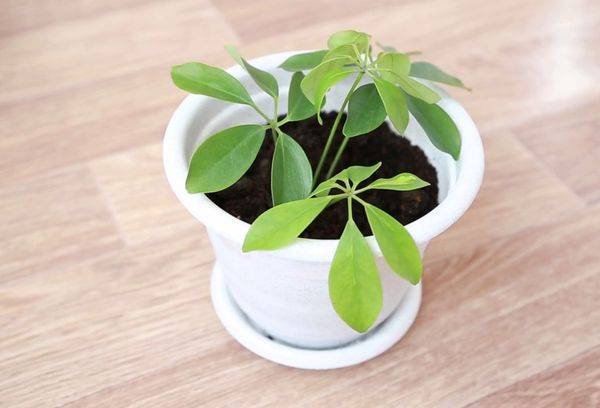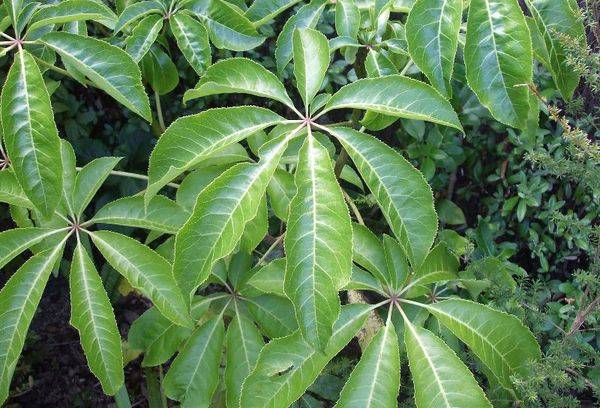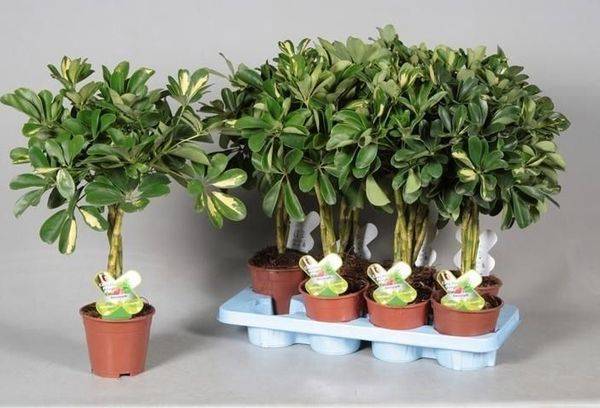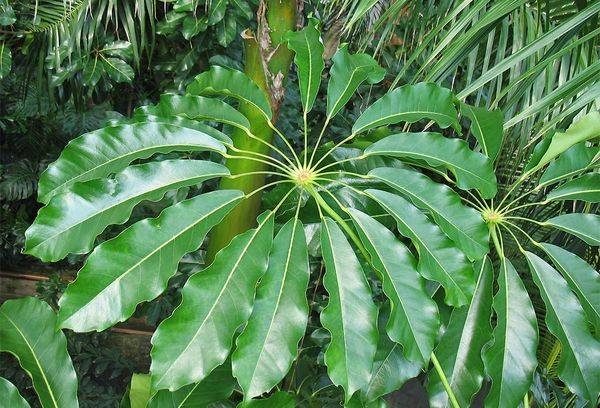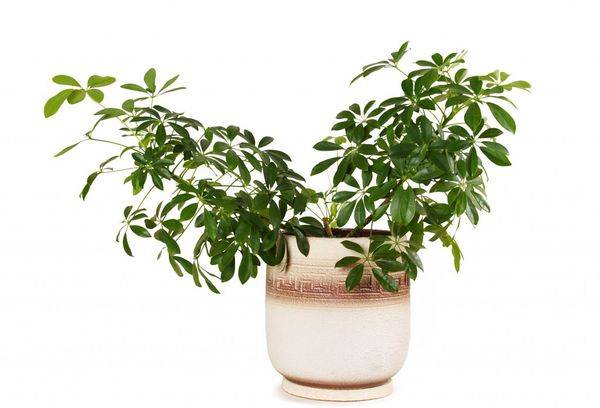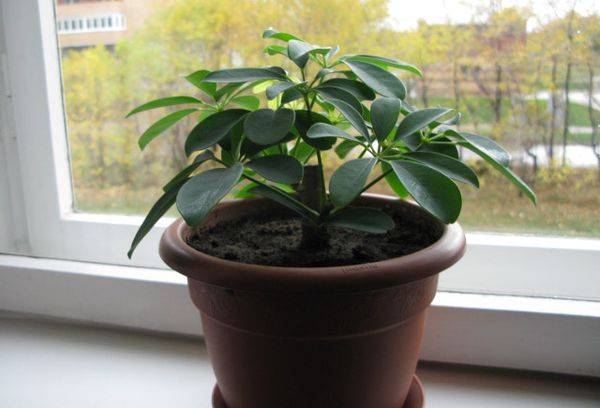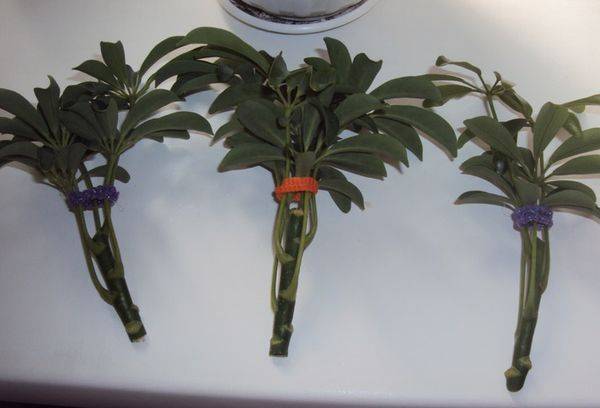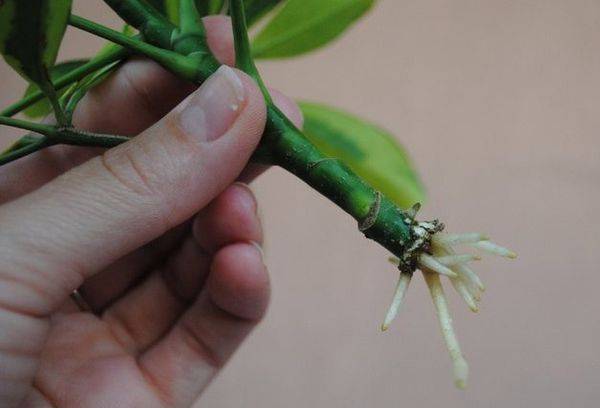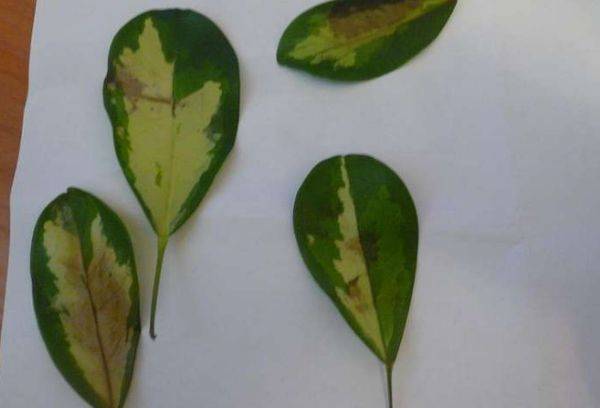Growing and caring for a sheffler at home
Content:
The Scheffler plant belongs to the Araliaceae family, grows in a tropical climate and has about two hundred species. At home, it is easy to provide conditions similar to natural conditions. Caring for a shefflera is not complicated, even an inexperienced gardener will cope with it.
The Brazilian umbrella was called so for the peculiarity of the leaves: they are cut into cirrus lobes (from four to 12) and deployed in a circle, like an open umbrella. Outwardly, it looks like several small leaves are collected in a rosette at the top of a thin shoot.
In culture, a plant very rarely produces flowers that resemble small tentacles. The main decorative value is represented by leaves, plain or variegated, and the crown forming a ball or tree.
Kinds
The most popular in home gardening are three types of umbrella trees:
- Schefflera octophylla - Scheffler's eight-leafed. This species is characterized by an original arrangement of leaves. On drooping cream cuttings, 8-12 lobes of a leaf having a lanceolate shape are attached. Their length is 40 cm, width - 10 cm. First, the leaves are glossy and olive green. Over time, they become light green. There are bright veins on the leaf plates, the reverse side is matte.
- Schefflera arboricola - Schaeffler tree. A small tree has a branching erect trunk. The branches are green at first, with time they become brown. Leaves up to 20 cm long, bright green, shiny. The Gold Capella variety has yellow spots on the leaves, and the plant itself looks like a palm tree. Gerd variety is most effective. The colors of the leaves, like the whole tree species, are green-yellow, bright, colorful and picturesque. The leaves are in the form of open sockets. Preferably, diffused lighting, protection against direct rays, however, in a shaded place, the color will fade.
- Schefflera actinophylla - Scheffler stellate, or radiant. This is the most popular variety. The trunk is erect, thickened downward, dark in color. Has long red-brown petioles. The leaves are egg-shaped, with wavy edges, bright green, with a glossy surface. The veins are lighter than the base of the leaf. Nova variety is distinguished by leaves resembling oak.
Lighting and comfortable temperature
In a room for shefflers, diffused but bright light is most suitable. It is better to use artificial lighting, as direct sunlight will cause burns on the sheet plates.
Tip
Resource purityis.decorexpro.com/en/ recommends growing a sheffler on windows facing west or east. However, plant varieties with green, uniform leaves will feel great on the north side too.
In winter, if the room temperature is above 17 degrees, the flower must be placed in a very bright place, create additional lighting using lamps. In the summer, the plant is allowed to be kept outdoors, avoiding direct exposure to leaves of sunlight.
In summer, a temperature comfortable for growing is + 20 ° C, and night coolness is not a threat.
In winter, the ambient temperature should not be lower than + 12 ° C. The optimal range is from 15 to 17 degrees.
Watering and spraying
Watering should be 2 days after the topsoil has dried. At the same time, the earthen lump should not dry out completely. For irrigation, soft, pre-settled water of room temperature is used.
In winter, watering should be reduced. It is crucial that the soil in the pot does not sour, since prolonged excessive wetting of the earth is dangerous for plants with rot.
Tip
You can not put a flower in the immediate vicinity of heaters and heaters, since this is extremely detrimental to its development and leads to death.
Humidity in the room should be increased. In this regard, the tree must be sprayed three times a week. It is recommended to place a pot with a shefflera on a pallet filled with crude expanded clay. Additional, foliar moistening is especially necessary for the plant in winter, when the air in the room is dried by the heating system.
Top dressing
During active growth, the bush is fed with complex fertilizers containing nitrogen. This helps the sheffler to form a green mass.
Fertilizers are usually used for indoor plants and are applied once every two weeks from spring to autumn. However, it is not advisable to feed young and recently transplanted plants.
Pruning and transplanting
To get a thick crown, you need to plant several plants in one container. Then you should form a bush of the required size with the help of pruning. A single sheffler is usually shaped like a tree. In addition, the bush looks spectacular paired with Benjamin's ficus, and the tree looks great next to the truncate truncate (truncated) cactus. Young shefflers have very thin stems. So that in the future we get a powerful beautiful tree, they are fixed on a support.
The need for pruning depends on the variety. Radiant species with only one stem are not necessary to trim. The purpose of this wood sheffler treatment is to save space. If the bush has grown greatly, the upper shoots are partially cut off, which leads to their branching.
Tip
In order for the plant juice not to get on the skin and cause its irritation, pruning should be carried out with extreme caution and in household gloves.
Shefflers transplant every 2 years. In this case, choose a pot much larger than the previous one. The earth mixture is prepared slightly acidic, consisting of 2 parts of turf, as well as one part of sand and humus. To prevent stagnation of moisture in the pot, drainage is mandatory.
Breeding
This process presents some difficulty for beginners. Shanks are considered traditional planting material, but the sheffler also propagates by seeds and air layering. Consider all the options.
Growing from seeds. They are sown at the end of winter. Use a peat-sand substrate in a ratio of 1: 1 or a mixture that includes sand, sheet soil and turf in a ratio of 1: 1: 1. Before sowing, the soil must be disinfected, and the seeds should be kept in warm water. They are planted with an indent of 1-2 cm from each other, watered and put in a warm place (20-23 ° C).
The seed tank must be periodically ventilated and the soil sprayed. When 2-3 leaves appear on the sprouts, they are transplanted into separate pots. During the first three months it is required to maintain a temperature of 17-19 degrees. As the pots are filled with roots, the plants are transplanted in containers with a diameter of about 9 cm, and the air temperature is reduced to 13-15 ° C.
In the autumn months, it is permissible for a sheffler to transfer into a pot, whose diameter is 10-12 cm, into a substrate consisting of 2 parts of turf and one part of sand and sheet soil.
Propagation by cuttings. First, it is necessary to treat the semi-lignified cuttings with a stimulator that promotes root formation. Then plant in sand and peat soil. The container must be placed in a warm place (it is not recommended to place it on heating devices). It is necessary to ensure that the temperature is not lower than 20 and not higher than 22 degrees.
A plastic film is pulled onto the surface of the container to provide diffused light and optimal humidity to the cuttings. From time to time, seedlings should be aired and sprayed.
After rooting the cuttings, the temperature must be reduced to 18 ° C. When the pot is filled with roots, the sheffler is transplanted into containers with a diameter of 9 cm, and the ambient temperature is reduced to 16 degrees.
Reproduction by air layering. For this method, a large bush of room shefflers is already used. In early spring, a small incision is made on the trunk. A lump of sphagnum moss, watered with a nutritious composition, is applied to it, and is wrapped with a film on top. They make sure that the moss does not dry, periodically moisturize.
A few months later, roots appear at the site of the incision. After 2 months, the trunk of the tree is cut below the appeared roots and planted in another container.
The lower remaining part of the plant should be cut off under the root and continue to water. As a result, shoots will arise, and instead of one plant there will be several.
Tip
The stems and leaves of room shefflers contain toxic substances, so after contact with the plant, be sure to wash your hands thoroughly to avoid dermatitis.
Diseases
If the plant is properly looked after, then at home a healthy strong tree will grow. It should be remembered what negative aspects can lead to diseases.
Leaves fall. At a very high temperature in the summer season, a sheffler often drops leaves. They also fall with excessive moisture in the soil and low temperatures in the winter.
There are spots on the leaves. If the lighting is insufficient, then the color of the sheet plates fades. Excess of sunlight leads to the appearance of spots of light shade. Brown spots - probably the plant received a sunburn.
The bush rots. If the soil is excessively moistened for a long time, the roots of the plant will be affected by rot. The tree must be removed from the pot, inspect the roots and cut off the affected areas. After that, the left roots must be immersed in a solution of a growth stimulator (Zircon, Epin and others), and then disinfected. For this, crushed coal or Fitosporin is used. After processing, the plant must be planted in fresh, moist soil. Wrap the pot with plastic wrap and hold for about a week. From time to time, the film must be removed to ventilate and water the flower.
The leaves deteriorate. They will deteriorate around the edges and turn brown if not provided with sufficient watering. The same reaction of the plant to very dry air.
Pests
The most common pests of Schefflers are aphids and scale insects. This plant also likes a spider mite. Due to the invasion of parasites, the growth of the bush slows down, the leaves turn yellow and fall off. If you do not start pest control, the plant is likely to die.
Aphids are a fairly large insect. It is usually removed mechanically. Parts of the bush, strongly affected by pests, must be carefully cut. Then carry out processing by means, which includes permethrin. If the plant is severely damaged, and the insect has bred, then you need to repeat the treatment.
If signs of infection with scabies are found on the bush, it is necessary to isolate it and examine the remaining nearby flowers. Treatment with insecticidal solutions is sometimes ineffective, since the shield protects the insect from preparations. Mechanical removal will help. A piece of cotton wool or fabric should be moistened in Karbofos, Aktellik or Aktare and walk along the leaves, removing insects - all to one, otherwise they will multiply again. If the bush is severely affected by the scabies and the parasites cannot be completely removed, it is better to destroy the flower.
One of the most dangerous pests is the spider mite. At an early stage of damage, the treatment of leaves and trunks on both sides with a soap solution will be effective. If the plant is severely affected, then insecticidal preparations should be used.
Following the advice of professional flower growers, you will not encounter problems when growing a spectacular houseplant shefflers.
